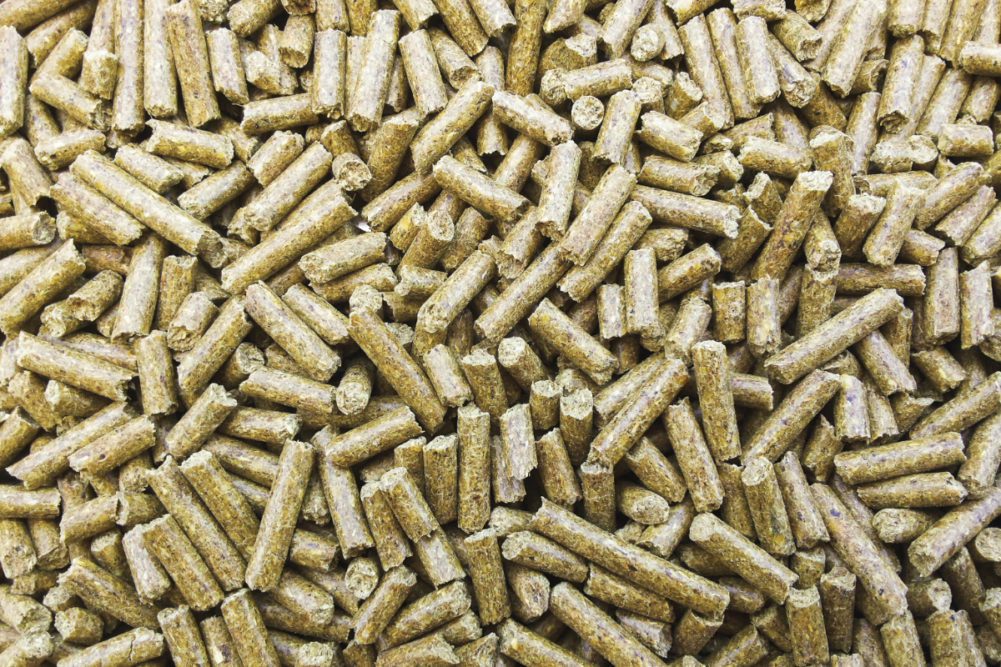MANHATTAN, KANSAS, US — Determining ingredient quality prior to diet formulation or feed manufacturing is an important tool for precision feeding in swine production. Visual appearance, microbiological and chemical analysis tests commonly are used to determine quality of ingredients.
Inspecting grains at receiving gives opportunity to file deficiency claims. Supplier relationships and monitoring procedures are critical for ensuring quality ingredients. Evaluating the receiving procedures and collecting samples for testing will provide information for adjustments needed to provide quality feed.
Sampling
To determine the best sampling equipment, the length of the tool should reach the bottom of the container being sampled. Larger diameters should be used for whole grain ingredients and smaller diameters used for ground ingredients. Equipment used to provide a representative sample include grain probes and sampling triers. When using a grain probe, the probe should be closed when inserted into the product and then twisted to reveal holes, allowing grain to flow in. Equipment used for cut stream sampling includes pelican samplers or PVC pipe samplers.
Results from ingredient analysis can only be as good as the sample taken. Therefore, a sample must be representative of the entire lot to be meaningful. Sample timing and location must be considered. A representative sample for freeflowing and static material can be obtained by either timed collection every 1 to 5 minutes during the unloading process or strategically sampling at predetermined locations of bags or bulk containers.
For automatic sampling, proper installation where a representative sample of material can be obtained and specific timing of when the sample is taken will determine the quality of the sample. Another option is cut stream sampling during unloading, depending on safety and accessibility. The sample should be taken in the middle of the load and stream flow may need to be reduced while collecting to prevent overflow of the sampler equipment. Collection should be a side-to-side sweep of the sampler, collecting the entire stream.
A pre-unloading sample used for visual inspection is another option where the receiving pit cover remains in place and a small amount of ingredient is let out onto the cover to be used for visual inspection or analysis prior to unloading. Approximately 1-pound samples should be collected to be used for analysis and sample retention.
Determining when official analysis via commercial laboratory is necessary will depend on the concern. However, when evaluating a new supplier, proximate analysis should be used to assure ingredient quality with a commercial laboratory or on-site QA laboratory. Testing should be more frequent for byproduct and alternative ingredients.
Labeling should be done to ensure proper sample identification and include a minimum of sampling date, ingredient name, lot ID, and sampler identification. Containers used for sample storage should be cleaned prior to use. Plastic bags or sterile plastic bags are best used for dry ingredient storage. Liquid samples should be stored in plastic or glass containers. Samples are best stored in a refrigerator or freezer, however, if storage space is limited, sample priority for freezers should be highest to lowest moisture content and lowest to highest frequency of use.
Storage outside of a freezer or refrigerator should still be in a cool, dry place with low humidity. Samples should not be retained past ingredient shelf life when stored outside of a freezer. Retained samples should be kept at minimum while the ingredient is being used and depending on the associated risk of spoilage or biological hazards thereafter.
 Credit: ©KANSAS STATE UNIVERSITY
Credit: ©KANSAS STATE UNIVERSITYReceiving procedures
Prior to accepting an ingredient, trucks and documentation need to be inspected. Feed mills must be registered and in compliance with the US Bioterrorism Act for record-keeping and traceability. Transporters and non-transporters (feed mills) must maintain records that identify both transporter and non-transporter supplier and recipient. Transporters must maintain records of origin, date received/delivered, quantity, product description, route and transfer points. Non-transported must have previous source, date of receipt/outbound shipment, product, quantity, transporter and supplier/lot code number. Records must be kept for two years.
Bulk trucks should be free of external material buildup such as mud, slush and dirt. Bagged ingredients should be evaluated for damaged bags. Ingredient weight of bulk and bagged ingredients should be compared with delivery tickets. All shipping documents and delivery tickets should be reviewed and retained. During unloading the receiving pit should be visually inspected and cleaned as needed prior to receiving of the next bulk ingredient to minimize cross-contamination. Pit covers should be in place as trucks drive over receiving grates to keep debris from trucks and potential pathogens from entering the facility.
If there is ingredient spillage during unloading, ingredients that have touched the floor should be disposed. Spillage can be minimized by use of guards around receiving pits and slowing down unloading speed. Under no circumstance should spilled ingredients be swept into the pit to minimize risk for pathogen cross contamination. For micro ingredients, bulk and bags should be visually inspected and used on a first-in, first-out rotation. For liquid ingredients, all lines should be properly labeled, and line caps locked to secure against improper unloading. For drug receiving, the documentation should be recorded.
The samples’ odor and visual appearance can help decide quality and basis of rejection of some products. Therefore, it is encouraged to take a sample prior to unloading if possible. Whole grain ingredients such as corn can be visually inspected for excessive broken corn foreign material (BCFM) and indication of toxins and should be tested to evaluate moisture and mycotoxins. Bagged ingredients must be sampled for visual inspection. Visual inspection by personnel of byproduct ingredients or processed ingredients such as dried distillers’ grains with solubles (DDGS), soybean meal, fat sources, etc. is helpful in determining when to run further tests.
If rejection of an ingredient is necessary, the supplier should be notified within the same business day and provided necessary documentation. Additionally, filing a deficiency claim when ingredients do not meet established specifications will decrease added cost from ingredient compensation and demonstrates commitment to quality for employees and supplier.
Once a sample is taken, required testing should be determined. Type of testing is determined by variability of ingredient, frequency of use, and/or degree of problem. Byproduct and coproduct ingredients are most likely to be highly variable. Options for testing include visual and physical inspection, use of quick tests (if applicable), or use of a commercial laboratory.
To alleviate the risk of segregation in a sample bag, samples should be subdivided or subsampled by a sample divider (riffle) prior to analysis. The sample should be divided until the amount needed for analysis is obtained. Rapid testing methods help nutritionists and production systems react quicker to changes in processes. Keep records of ingredient testing to evaluate supplier compliance and find historical data trends.
Grading and test weight (bulk density) of grains: Grain grading is done to maintain grain quality that can be affected by growing and storage conditions. Bulk density of an ingredient should be determined according to ASABE Standard S269.4 (2007). The ingredient is poured into a cylindrical container from a certain height to facilitate free flowing of the samples until the container overflowed. The excess material is removed by striking a straight edge across the top of the container. Net weight of the ingredient is obtained by subtracting the weight of the empty container from the combined weight of the ingredient and container. Bulk density is calculated by dividing the mass by the container volume.
Moisture content: Determining the moisture content of an ingredient is important for making decisions pertaining to storage, shrink, and other feed milling processes. Moisture analysis of whole grain ingredients should be done for every incoming load because of the impact that added moisture can have throughout the feed manufacturing process. Options for rapid analysis of moisture include using a DickeyJohn moisture analyzer or NIRS.
Fat: Fat quality can be evaluated by a combination of oxidative and hydrolytic rancidity. Oxidative rancidity can be measured by lipid peroxidation using a combination of primary and secondary oxidative products from peroxide value or thiobarbituric acid reactive substances (TBARS) tests, respectively. Additionally, hydrolytic rancidity tests include free fatty acid tests. Fat sources should be used as quickly as possible therefore only receiving the amount needed monthly can reduce risk of fat rancidity. Additionally, use of an antioxidant can prevent the risk of fat rancidity.
Mycotoxins: Mycotoxins can be produced in the field or in storage. Field toxins include, deoxynivalenol (vomitoxin), zearalenone and fumonisin and storage toxins include aflatoxin and ochratoxin. To determine the risk of mycotoxin contamination from grains, weekly reports are available to assess the risk of mycotoxin contamination in grains from a specific area, which can help determine how many loads to sample. Lateral flow test strips or enzyme-linked immunoassay kits can be used as a single mycotoxin test to determine toxin level present in ingredients. It’s important to note that each type of mycotoxin requires a specific test. Official laboratory testing should be done if pigs show signs of mycotoxin contamination and the quick test does not show positive results.
Summary
Determining the quality of ingredients at receiving is critical for accurate formulation and strategic feeding. A representative ingredient sample is important to establish accurate nutrient profiles for each ingredient. There are numerous factors that influence the quality of sample, including ingredient characteristics, sample technique, sample tools, and the point in time the sample was taken. Use of quick tests allows for fast, informed decision-making and eventually can lead to decreased commercial laboratory evaluation cost.
Chad Paulk is an assistant professor of feed science and management in the Department of Grain Science and Industry at Kansas State University. He may be reached at [email protected].






